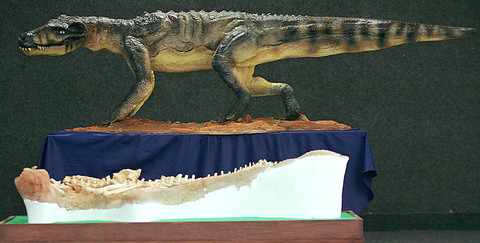Brazilian paleontologists last week proudly put on display a skeleton of a crocodile that roamed the earth in the time of the dinosaurs 90 million years ago.
The remains of the Baurusuchus salgadoensis were well preserved and included a complete head, said Pedro Henrique Nobre from the University of Rio department of geology, where the presentation was held.
"Finding a fossil is rare, but finding a collection of fossils [from the same animal] is even more rare and finding an intact head is extraordinary," Nobre said.

PHOTO: AP
The Baurusuchus was 3.5m long, and scientists estimate it weighed 400kg.
The paleontologists also presented a life-size reconstruction of what they believe the creature looked like.
The Baurusuchus remains were found 15 years ago in the western region of the state of Sao Paulo. It is the first time they have gone on display after years of restoration.
Unlike modern-day crocodiles, the Baurusuchus lived on land in a dry area. The location of the creature's nasal pasages indicated that it could not spend much time underwater, Nobre said.
The reptile had longer and more powerful rear legs than modern crocodiles, and the animal's teeth indicte that it was an active predator, he added.
The Baurusuchus belongs to the same family of ancient reptiles whose remains have been found in Argentina, southern Africa and the region between India and Pakistan. The scientists said their discovery suggests that an ancient land bridge linked South America to Indo-Pakistan.
The creature lived in the Cretaceous period, which lasted from 144 to 65 million years ago. It was the last period during which dinosaurs lived.

We lay transfixed under our blankets as the silhouettes of manta rays temporarily eclipsed the moon above us, and flickers of shadow at our feet revealed smaller fish darting in and out of the shelter of the sunken ship. Unwilling to close our eyes against this magnificent spectacle, we continued to watch, oohing and aahing, until the darkness and the exhaustion of the day’s events finally caught up with us and we fell into a deep slumber. Falling asleep under 1.5 million gallons of seawater in relative comfort was undoubtedly the highlight of the weekend, but the rest of the tour

Youngdoung Tenzin is living history of modern Tibet. The Chinese government on Dec. 22 last year sanctioned him along with 19 other Canadians who were associated with the Canada Tibet Committee and the Uighur Rights Advocacy Project. A former political chair of the Canadian Tibetan Association of Ontario and community outreach manager for the Canada Tibet Committee, he is now a lecturer and researcher in Environmental Chemistry at the University of Toronto. “I was born into a nomadic Tibetan family in Tibet,” he says. “I came to India in 1999, when I was 11. I even met [His Holiness] the 14th the Dalai

Following the rollercoaster ride of 2025, next year is already shaping up to be dramatic. The ongoing constitutional crises and the nine-in-one local elections are already dominating the landscape. The constitutional crises are the ones to lose sleep over. Though much business is still being conducted, crucial items such as next year’s budget, civil servant pensions and the proposed eight-year NT$1.25 trillion (approx US$40 billion) special defense budget are still being contested. There are, however, two glimmers of hope. One is that the legally contested move by five of the eight grand justices on the Constitutional Court’s ad hoc move

Stepping off the busy through-road at Yongan Market Station, lights flashing, horns honking, I turn down a small side street and into the warm embrace of my favorite hole-in-the-wall gem, the Hoi An Banh Mi shop (越南會安麵包), red flags and yellow lanterns waving outside. “Little sister, we were wondering where you’ve been, we haven’t seen you in ages!” the owners call out with a smile. It’s been seven days. The restaurant is run by Huang Jin-chuan (黃錦泉), who is married to a local, and her little sister Eva, who helps out on weekends, having also moved to New Taipei